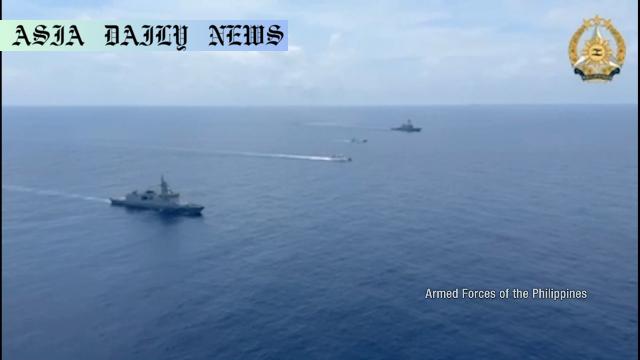Maritime Drills: The Philippines and US join forces in maritime exercises in the South China Sea amidst rising tensions.
The Philippines and the US conduct joint maritime drills in South China Sea waters claimed by Manila.
These exercises showcase a commitment to upholding a free, open, and secure Indo-Pacific region.
Tensions between Manila and Beijing remain over disputes in the South China Sea.
The US plans to build two naval maintenance facilities in Palawan Province.

Strengthening Alliance Through Maritime Drills
The Philippines and the United States have commenced a series of joint maritime drills in the contested waters of the South China Sea, an area rife with geopolitical tension. On Wednesday, naval and aerial assets from the Philippine navy and coast guard collaborated with advanced U.S. military destroyers and maritime aircraft. The timing of these exercises is critical, occurring mere days ahead of Philippine President Ferdinand Marcos Jr.’s official visit to Washington. The move is designed to reaffirm the two nations’ commitment to ensuring an open, secure, and stable Indo-Pacific region.
The joint exercises underscore the long-standing security alliance between the United States and the Philippines, especially amidst mounting tensions with China. The drills also serve as a platform to test coordination and operational readiness between the two nations while sending a strong diplomatic message about their intention to preserve freedom of navigation in one of the world’s most strategic waterways. The activity comes at a time when the U.S. has ramped up efforts to deter what it perceives as China’s increasingly assertive behavior in the region.
Geopolitical Implications in the South China Sea
China’s aggressive territorial claims over the South China Sea have long been a hotspot for international disputes. In response to these claims, the Philippines has consistently sought to maintain its sovereignty over portions of the area it considers its territorial waters. In fact, just a few months ago in May, an incident occurred where a Philippine research vessel was sideswiped and subjected to water cannon attacks by a Chinese ship. This has only further solidified Manila’s resolve to strengthen its naval capabilities and its ties with the United States.
To bolster defense capabilities, the Philippines has agreed to the U.S.’s proposal to establish two naval maintenance facilities in Palawan Province, located adjacent to the disputed waters. These facilities are expected to enhance logistical support for Philippine military watercraft, ensuring that naval assets remain fully operational. Such developments contribute significantly to the region’s overall security dynamics, enhancing Manila’s ability to protect its waters and increasing U.S. presence in a geographically strategic area.
Commitment to Regional Security
As part of its broader strategy, the United States has emphasized its commitment to maintaining free and open navigation in the Indo-Pacific region. This is especially crucial in the South China Sea, a critical maritime trade passage accounting for a substantial portion of global shipping traffic. Both the U.S. and the Philippines view the recent drills as more than simple military exercises. Instead, they represent an ongoing commitment to counter efforts that could disrupt this stability.
These maritime engagements reflect America’s steadfast military cooperation with its allies in Southeast Asia, asserting its position against unilateral actions that threaten peace. Meanwhile, the Philippines’ participation in these activities not only underscores its loyalty to the alliance but also sends a clear message about its security priorities in the face of perceived threats.
Looking Ahead: Strategic Collaboration
The developments mark a significant step in deepening military cooperation between Washington and Manila. With regional tensions unlikely to dissipate in the short term, such engagements are expected to continue playing a crucial role in both nations’ defense strategies. The construction of maintenance facilities in Palawan, combined with recurring military exercises, will ensure that the Philippines remains a pivotal ally for the U.S. in this strategic region.
Furthermore, as President Ferdinand Marcos Jr. prepares to visit Washington, the alliance is likely to approach new heights, furthering the partners’ shared objectives. The enhanced presence of the U.S. in the Indo-Pacific not only stabilizes the region but also fortifies its ties with countries seeking to deter China’s increasing boldness. Ultimately, the drills demonstrate a unified approach to safeguarding the principles of international law and freedom of navigation.



Commentary
The Importance of Strategic Partnerships
The recent maritime drills between the Philippines and the United States exemplify the essence of strategic alliances in the face of global challenges. In today’s geopolitical landscape, no nation can sustain security and stability alone. The drills in the South China Sea are not merely military movements but symbolic gestures that demonstrate the Philippines’ willingness to collaborate with global partners to assert its sovereignty and ensure regional security. The U.S., on the other hand, reaffirms its commitment by standing alongside its allies, aligning with its broader Indo-Pacific strategy.
Upholding Freedom of Navigation
The South China Sea’s significance cannot be overstated—it serves as a vital artery for global maritime trade. Freedom of navigation in this region is a cornerstone for ensuring economic stability worldwide. The joint exercises between the Philippines and the U.S. serve as a critical measure to deter challenges to this freedom. By showcasing military preparedness and cooperation, both nations send a clear signal to any state looking to upend the status quo. This collaboration underscores the importance of multilateral action in addressing global issues, emphasizing unity over isolation.
A Future of Collaboration and Resolve
These developments highlight the resilience and adaptability of alliances in turbulent times. The decision to deepen ties through military drills and the construction of strategic facilities signifies a forward-thinking approach by both nations. It also demonstrates the necessity of proactive measures to counter emerging threats. Such actions, however, must be paired with diplomatic efforts to de-escalate tensions and build lasting peace. The path ahead requires balanced decisions, and it is inspiring to see nations like the Philippines and the U.S. rise to the occasion with resolve and unity.